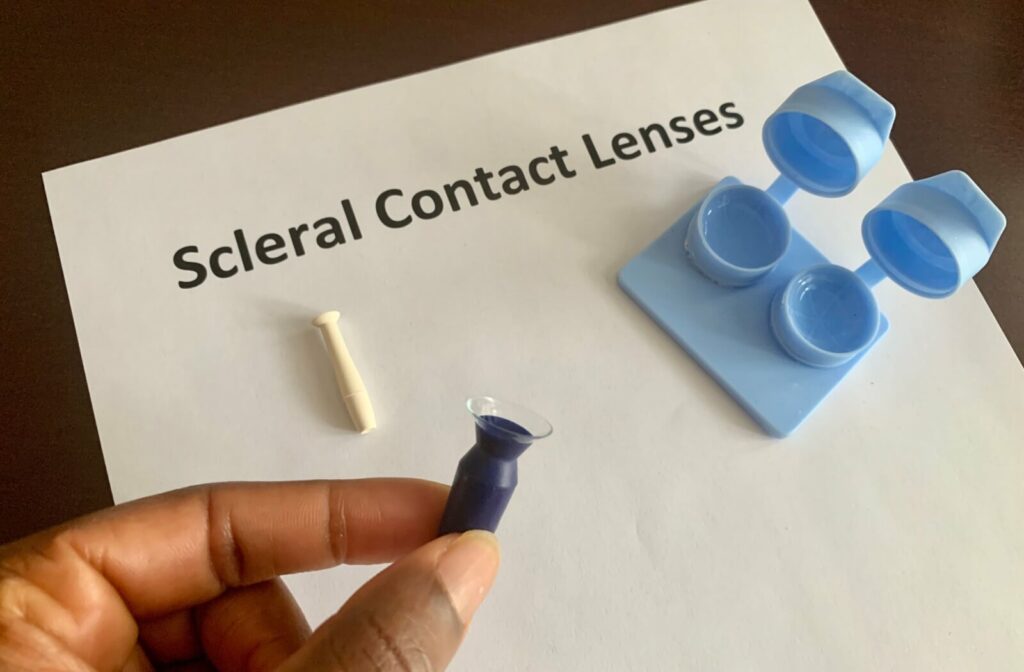Scleral contact lenses can provide an appealing mixture of visual clarity and comfort for those with certain eye conditions.
To reap the full benefits of these specialized lenses, we’ve created a comprehensive guideline that outlines:
- The technology behind scleral lenses
- Scleral lens fitting
- How to clean, store, and properly remove scleral lenses
Understanding Scleral Contact Lenses
Unlike traditional soft contact lenses that rest on the cornea, scleral lenses vault over the corneal surface and rest on the sclera. This unique design creates a moisture-filled reservoir of saline solution over the cornea, providing exceptional comfort and all-day hydration.
Scleral lenses are custom-made for each wearer from a gas-permeable material that allows oxygen to reach the cornea. This design aids in maintaining corneal health and preventing complications from prolonged lens wear.
Scleral lenses are a great corrective lens option for those with specific eye conditions like:
- Keratoconus
- Severe dry eye syndrome
- Irregular corneas from previous surgeries or injuries
- Poor comfort or visual stability in traditional contact lenses
Your Scleral Lens Fitting
The sharp visual correction and all-day comfort provided by scleral lenses are partly a result of their custom-made design.
When lenses are perfectly fitted to the unique shape and size of a patient’s eyes, the resulting increased stability reduces the lenses’ chances of shifting when the wearer blinks and minimizes other complications associated with ill-fitted lenses.
An annual contact lens fitting is necessary for all contacts, but is especially important for scleral lenses.
Over time, subtle changes can develop in your ocular health, corneal shape, and vision, potentially affecting the fit and comfort of your lenses.
Regular visits assess whether you should continue wearing scleral lenses and adjust for any changes to the shape and size of your eyes or your vision prescription.
The scleral lens fitting process is a comprehensive and personalized experience that helps patients receive lenses tailored to their specific needs.
After your initial contact lens exam, here’s what you can expect:
- Diagnostic Tests: During your ocular health assessment, your optometrist will use tools to assess the state of your cornea, sclera, and tear film.
- Ocular Surface Mapping: A 3D profile of your eye’s surface is mapped to obtain precise measures of the sclera and cornea. This allows for the creation of a customized lens that matches the unique features of each patient’s eye.
- Insertion and Removal Training: During the fitting process, you’ll be taught how to correctly insert and remove your scleral lenses. This will allow you to handle the lenses safely and properly care for your lenses.
- Lens Trial and Assessment: After mapping, trial lenses are selected based on your eye’s specific measurements. You’ll have the opportunity to experience how these lenses feel and function in your daily life as you wear them for a week or two.
- Lens Customization: Based on the outcome of your lens trial, new lenses will be custom-designed to the specific shape of your eye. This may involve altering the curvature or diameter of the lenses to achieve the ideal balance between comfort and vision.
- Final Lens Delivery: Once your lenses are ready, you’ll return for a final fitting which includes one last visual test while wearing your lenses. This test confirms that your lenses have good fit, feel, and visual clarity.

Scleral Lens Wear & Care
To reap the full benefits of scleral contacts, proper lens wear and care is key.
Scleral lenses require diligent care and proper handling. We’ll go over all these details during your fitting, but here’s a helpful guide to refer back to.
Cleaning & Storage
- Cleaning: Always wash your hands with soap and water before handling your lenses. Doing so prevents contamination and eye infections. Use a recommended cleaning solution specifically designed for scleral lenses. Rub each lens gently with the solution to remove surface debris and deposits.
- Rinsing: Thoroughly rinse your lenses with a preservative-free saline solution. Don’t rinse or clean your lenses with tap water or saliva as either can introduce harmful debris and pathogens.
- Disinfecting: Place your lenses in a storage container filled with fresh disinfecting solution. Allow them to soak overnight or as recommended by your optometrist to make sure they’re free of contaminants.
- Storage: Store your lenses in a clean, dry case. Replace the case every three months to reduce the risk of bacterial contamination.
Scleral lenses should be replaced every 12 to 14 months. Regular replacement is necessary to maintain lens clarity and prevent surface scratches that can harbor bacteria and irritate your eyes.
Inserting & Removing Your Scleral Lenses
Once you’ve thoroughly washed your hands, you can begin inserting the lenses:
- Prepare the Lens: Start by cleaning and rinsing the lens with preservative-free saline solution. Fill the concave part of the lens with this solution.
- Hold the Eyelids Open: Use one hand to hold your upper and lower eyelids open to prevent your eye from blinking.
- Insert the Lens: Look straight down into the lens and gently raise the lens onto the center of your eye until you feel a connection. Release your eyelids slowly before slowly blinking over the lens to set it in place.
- Check Comfort and Vision: Blink a few times to make sure the lens feels comfortable and vision is clear.
Once you’ve washed your hands, scleral lenses can be removed using your finger or a suction tool.
- Place your Tool of Choice near the edge of the Lens: Using a suction tool, gently pull the lens out and away from your eye. If using fingers, gently open your eyelids so they are around the edges of the lens. Using the edge of the eyelids, apply gentle inward pressure on the eye to release the seal of the scleral lens. As you slowly blink, the lens will fall away from the eye. It is always a good idea to place a wash rag or rubber pad in the base of the sink to prevent lens loss if lenses are removed over a bathroom sink. Placing a towel on the countertop can also keep the lens from bouncing away if it falls during removal.
- Be Gentle: If the lens is difficult to remove, apply more saline solution to help with lubrication. Ensure the removal tool is applied near the edge of the lens, NOT the center. Use gentle pressure from your eyelids to encourage the release of suction between the lens and your eye.
- Clean the Suction Tool: After using the tool to remove both lenses, rinse the suction tool with a contact lens solution and let it air dry to maintain the tool’s hygiene. You may also swab it with isopropyl alcohol and allow to air dry after use. Replace application and removal tools every 1-3 months.
- Store the Lens: Thoroughly rinse the lens with saline solution before placing the lenses in the case with fresh, approved cleaning solution.
Schedule a Fitting
By consistently following these guidelines, you can enjoy the benefits of scleral lenses safely. Connect with our team at Tree City Eyecare to schedule your scleral lens fitting!


